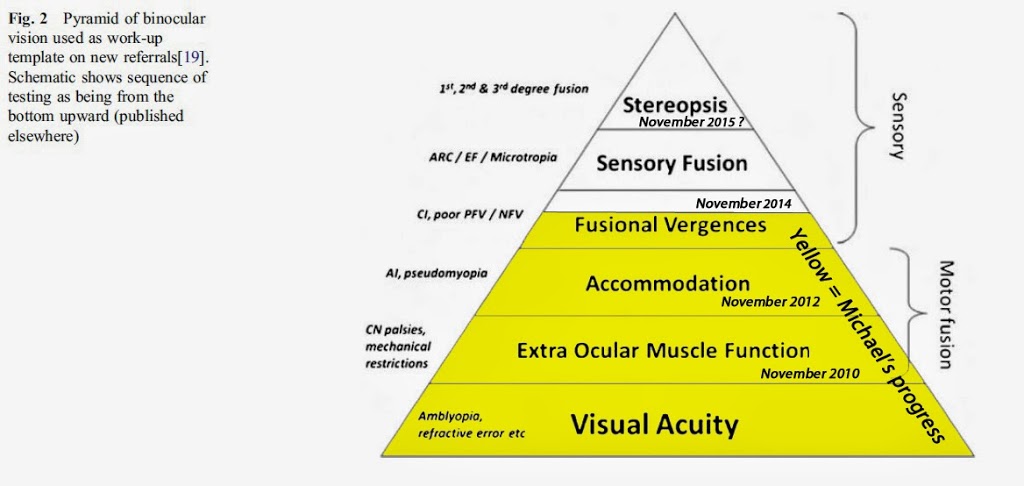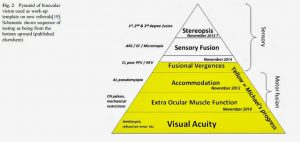
Check-up 9: Our four year anniversary
On December first I had my half yearly optometric evaluation. Sight in both eyes is good but the axis of astigmatism in my left eye has shifted marginally.
This is my current Rx.
OD: +2.50
OS: +2.50 cyl -1.0 axis 35°
When testing my binocular vision my ocular motor abilities are approximating what it should be. When testing sensory fusion things are less clear. Looking through an haploscope using some basic targets I do perceive the suppression controls and have what looks like a consistent and fused image. Based on this my optometrist tells me I have ‘central and peripheral fusion’. I’m not so sure though. Using anaglyph (stereo)targets I do not perceive ‘luster’ fusion, rather I perceive constant switching between red and green. It seems hard to agree on a definition of fusion. It is true that even though I might still have some form of intermittent and partial suppression at times, it is very easy to consciously break that suppression. Nonetheless it might still be too conscious a decision, especially while in motion. (More about the issue of unconscious intermittent and partial suppression and a potential solution in later blog posts).
In stereo targets, as seen through the haploscope, I can discern the correct relative distance between various elements of the picture by the way my eyes converge or diverge while viewing each of them in turn. When using polarized stereomaterials I do not directly perceive any 3D. To sum up, during none of the tests did I perceive any salient 3D but there are promising signs. “Certainly no bad news today.”, the optometrist said.

Revised ‘timeline’ – Last surgery was in August 2009
In order to add more perspective, I’d like to translate and paraphrase some of the conversation I had with him in Dutch.The challenge as a chronically untreated young adult with strabismus would have been to overcome the neurological atrophy and the decay of my vision, both motorically as perceptually, as it unfolded ever since my visual development went array. Compared to the current undertaking, that would have been relatively easy. Not easy, but relatively easy. However, I (and my optometrist with me) would say that eighty percent of my recovery is about overcoming the abysmal results of the surgeries I have undergone as a young adult (ages 16, 18, 19) completely obliterating my academic and professional prospects. That is why I am about to enter my fifth year of Vision Therapy.
MICHAEL: “Let’s forget I’ve been doing this for four years and I were to walk into your office for the very first time in my current condition. What would you tell me?”
G. NAEGELS: “I would tell you you have a slight exophoria and all physiological preconditions for stereopsis recovery are present. In view of the fact that you only developed strabismus at the age of three (accommodative strabismus) your recovery prospects back then would have been excellent. At that age it is very likely you have already SEEN in stereo up until the binocular disruption. I’d recommend for you to try and re-acquire stereo vision because it will greatly improve the quality and stability of your vision and life in general. I think it’s within reach now. But it has to happen of course.”
MICHAEL: “I’ll have to make it happen then.”
G. NAEGELS: “That being said, I still think that deontologically speaking I made the right call four years ago by telling you there was not much hope for recovery. Not every patient is as motivated and persistent as you are. I could not have foreseen that and I would not want to arouse expectations that can not be met by the optometrist alone. I’ve never seen someone so engaged in his recovery. I’m very happy to may have witnessed this in person. It’s a pleasant surprise for me and it reaffirms what we are doing here.”
MICHAEL: “Thanks. I have no other option so I act pragmatically. It’s swim or drown. It’s that simple. This HAS to work out.”